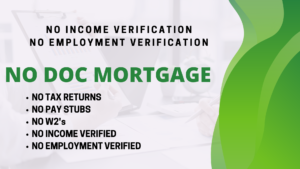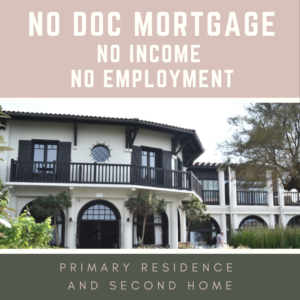Introduction
In a rapidly evolving mortgage landscape, traditional income verification processes can sometimes pose challenges for certain borrowers. This is where the concept of “No Income Verification Mortgages” comes into play. These mortgages offer an alternative route to homeownership for individuals who might not have the typical documentation required for conventional loans. In this article, we will delve into the details of no income verification mortgages, exploring their benefits, eligibility criteria, and potential drawbacks.

Understanding No Income Verification Mortgages 2023
What Are No Income Verification Mortgages 2023?
No Income Verification Mortgages 2023, often referred to as “stated income” or “low doc” loans, are a type of home loan where borrowers are not required to provide traditional proof of income, such as pay stubs, tax returns, or W-2 forms. Instead, applicants can state their income on the application, providing a simplified process that can be appealing to those with unconventional income sources or complex financial situations.
Unlike traditional mortgages that heavily rely on documented income, no income verification mortgages focus more on the creditworthiness of the borrower. Lenders typically look at credit scores, employment history, and the applicant’s ability to make a down payment. These mortgages often come with slightly higher interest rates and may require a larger down payment as a compensating factor for the reduced income documentation.
How Do They Work?
No Income Verification Mortgages 2023 work differently from traditional mortgages in terms of the income documentation required. Instead of relying on extensive paperwork like pay stubs and tax returns, these mortgages emphasize other factors such as creditworthiness and employment history. When applying for a no income verification mortgage, borrowers provide less detailed income information and can state their income on the application form. This streamlined approach can be particularly beneficial for individuals with irregular income sources or those who are self-employed.
Lenders will still assess the applicant’s credit score, employment stability, and ability to make a down payment. While the income verification requirements are reduced, lenders often offset the risk associated with less documentation by slightly increasing the interest rates and requiring a larger down payment compared to traditional mortgages. This helps protect their interests in case the borrower’s financial situation changes.
In essence, no income verification mortgages 2023 provide an alternative path to homeownership for those who might not have the typical income documentation but have strong creditworthiness and other compensating factors.

The Pros and Cons
Benefits of No Income Verification Mortgages 2023
No Income Verification Mortgages 2023 offer several benefits for specific borrowers who find themselves in unique financial situations. Here are some of the advantages:
- Simplified Application Process: Applying for a mortgage can be a complex and time-consuming process, especially when gathering extensive income documentation. With no income verification mortgages 2023, the application process is simplified. Borrowers can state their income on the application form, reducing the need for detailed paperwork like tax returns and pay stubs. This can be a major advantage for self-employed individuals, freelancers, and business owners who may not have a consistent income structure.
- Faster Approval Times: Traditional mortgage applications that involve thorough income verification can take a significant amount of time to process. No income verification mortgages 2023 often lead to faster approval times since there’s less documentation to review. This quick turnaround can be beneficial in competitive real estate markets where timing is crucial.
- Preservation of Privacy: Some individuals highly value their financial privacy. With no income verification mortgages 2023, borrowers need to disclose less personal financial information to lenders. While lenders still assess creditworthiness and other factors, the reduced need for income documentation can provide a level of privacy that traditional mortgages might not offer.
- Flexibility for Unique Income Sources: Many people today have non-traditional income sources. Entrepreneurs, freelancers, and those with rental properties often face challenges when trying to prove their income through conventional methods. No income verification mortgages 2023 accommodate these unique income sources, allowing borrowers to leverage their financial situation more effectively.
- Accessibility for Foreign Nationals: Individuals who are not citizens of the country where they are seeking a mortgage might face hurdles in providing the required income documentation. No income verification mortgages 2023 can be more accessible to foreign nationals, as they don’t need to navigate the complexities of proving income in a different country.
While these benefits can be appealing, it’s important for borrowers to carefully consider the potential drawbacks and assess whether the advantages align with their specific financial needs and goals.
Drawbacks of No Income Verification Mortgages 2023
While No Income Verification Mortgages 2023 offer certain advantages, they also come with potential drawbacks that borrowers should be aware of before pursuing this option. Here are some of the disadvantages:
- Higher Interest Rates: One of the significant drawbacks of no income verification mortgages 2023 is the possibility of higher interest rates. Since lenders are taking on increased risk by offering loans without thorough income verification, they may compensate for this risk by charging borrowers higher interest rates. Over the life of the loan, this can result in higher overall borrowing costs.
- Limited Availability: The availability of no income verification mortgages has decreased over time, particularly after the 2008 financial crisis. Stricter lending regulations and a greater focus on responsible lending practices have led many lenders to scale back or even eliminate these types of loans. As a result, borrowers might find fewer options to choose from.
- Potential for Default: Without the rigorous income verification process, there’s a risk that some borrowers might overestimate their ability to repay the mortgage. This can lead to default if they encounter financial difficulties down the line. This risk is why lenders often consider other factors, like credit history and down payment size, to mitigate the potential for default.
- Higher Down Payment Requirements: To offset the risk of reduced income documentation, lenders might require borrowers to make a larger down payment. While this can provide a sense of security for the lender, it can also present a financial hurdle for some borrowers who might struggle to gather a substantial down payment.
- Complex Financial Evaluation: While the application process might be simpler in terms of income documentation, lenders may place greater emphasis on other aspects of a borrower’s financial situation. This can include scrutinizing credit history, employment stability, and other factors, which might complicate the approval process.
- Potential for Unscrupulous Lending: In the past, some unscrupulous lenders took advantage of the flexibility in income documentation to approve loans to individuals who couldn’t realistically afford them. This played a role in the 2008 financial crisis. While regulations have tightened, borrowers should still exercise caution and ensure they are working with reputable lenders.
It’s important for potential borrowers to thoroughly assess their financial situation, research available options, and consider seeking advice from financial professionals before deciding whether a no income verification mortgage is the right choice for them.

Who Qualifies?
Eligibility Criteria for No Income Verification Mortgages 2023
Eligibility criteria for No Income Verification Mortgages 2023 can vary among lenders, but there are common factors that borrowers should keep in mind when considering this type of loan. Here are the key eligibility criteria:
- Good Credit Score: While these mortgages might require less income documentation, having a good credit score remains essential. A strong credit history demonstrates your ability to manage debt responsibly and can compensate for the reduced income verification. Lenders typically look for credit scores of around 680 or higher.
- Substantial Down Payment: Lenders may ask for a larger down payment to mitigate the risk associated with reduced income documentation. A substantial down payment not only reduces the lender’s exposure but also shows your commitment to the investment. While exact down payment requirements can vary, you might need to put down 20% or more of the property’s value.
- Proof of Assets: While not strictly income-related, having significant assets can improve your eligibility. This shows that you have resources beyond your stated income that can be used to cover mortgage payments.
- Property Type: The type of property you intend to purchase can influence your eligibility. Some lenders might be more willing to offer no income verification mortgages for certain property types, such as primary residences, compared to investment properties.
It’s important to note that while these criteria provide a general overview, lenders can have specific requirements that vary based on the lending institution, the current economic climate, and other factors. If you’re considering a no income verification mortgage, it’s recommended to reach out to potential lenders to discuss your eligibility and understand the specific terms they offer.
Is It Right for You?
Determining Suitability
Determining the suitability of No Income Verification Mortgages 2023 requires a thoughtful evaluation of your individual financial circumstances and goals. While these mortgages offer advantages for certain borrowers, it’s essential to consider various factors before making a decision. Here’s how you can determine if this type of mortgage is suitable for you:
- Income Stability: Assess the stability of your income sources. No income verification mortgages 2023 can be particularly beneficial for those with irregular income patterns, such as freelancers or self-employed individuals. If your income varies significantly month to month or year to year, this type of mortgage might align well with your situation.
- Creditworthiness: Examine your credit score and credit history. Since income documentation is reduced, lenders often place greater emphasis on creditworthiness. A good credit score can help offset the risk associated with limited income verification.
- Down Payment: Evaluate your ability to make a substantial down payment. Lenders often require larger down payments for no income verification mortgages 2023 to mitigate risk. Ensure that you have the necessary funds available for the down payment without straining your finances.
- Future Income Prospects: Consider your future income prospects. If you expect your income to increase significantly in the near future due to career advancements, business growth, or other factors, a no income verification mortgage might be a suitable choice.
- Risk Tolerance: Assess your risk tolerance. Due to the potential drawbacks, including higher interest rates and the risk of default, consider how comfortable you are with these risks. Evaluate whether the benefits outweigh the potential downsides in your unique situation.
- Long-Term Goals: Think about your long-term goals. Are you looking to buy a primary residence, an investment property, or a vacation home? Your goals can influence whether a no income verification mortgage aligns with your plans.
- Financial Advice: Seek advice from financial professionals. Consulting with mortgage advisors, financial planners, and accountants can provide valuable insights into whether this type of mortgage fits your overall financial strategy.
- Market Conditions: Consider the current real estate and lending market conditions. No income verification mortgages 2023 might be more or less available depending on economic factors. Being aware of market trends can help you make an informed decision.
By carefully evaluating these factors and seeking expert guidance, you can determine whether a No Income Verification Mortgage is a suitable choice for your unique financial circumstances and homeownership goals. Remember that making an informed decision is essential to ensure a positive borrowing experience.

Conclusion
No income verification mortgages 2023 provide a doorway to homeownership for individuals who don’t fit the mold of traditional income documentation. While they offer convenience and flexibility, borrowers must carefully consider their financial situation, risk tolerance, and long-term goals before opting for this type of mortgage. It’s recommended to consult with financial advisors and mortgage professionals to make an informed decision.
FAQs
- Are no income verification mortgages 2023 riskier for lenders? Yes, due to the reduced documentation, lenders take on more risk, which can be reflected in higher interest rates.
- Can I use a no income verification mortgage for an investment property? Some lenders might offer this option for investment properties, but eligibility criteria could be stricter.
- Do these mortgages have prepayment penalties? It varies by lender, so be sure to inquire about prepayment terms before committing.
- Are no income verification mortgages 2023 available for refinancing? Yes, refinancing options might be available, but they could have different terms than initial mortgages.
- How can I improve my chances of approval with these mortgages? Maintaining a good credit score, having a substantial down payment, and showcasing stable employment history can increase approval chances.

Mortgage-World.com
Comments are closed.